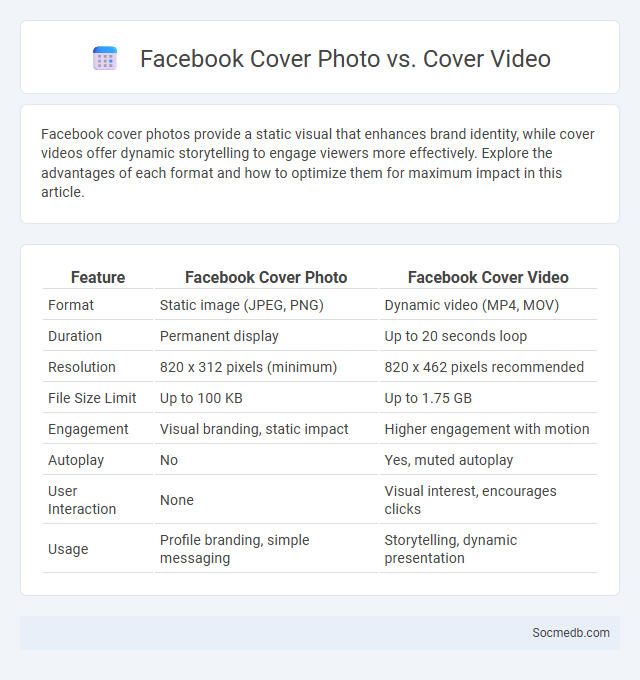
Photo illustration: Facebook Cover Photo vs Cover Video
Facebook cover photos provide a static visual that enhances brand identity, while cover videos offer dynamic storytelling to engage viewers more effectively. Explore the advantages of each format and how to optimize them for maximum impact in this article.
Table of Comparison
| Feature | Facebook Cover Photo | Facebook Cover Video |
|---|---|---|
| Format | Static image (JPEG, PNG) | Dynamic video (MP4, MOV) |
| Duration | Permanent display | Up to 20 seconds loop |
| Resolution | 820 x 312 pixels (minimum) | 820 x 462 pixels recommended |
| File Size Limit | Up to 100 KB | Up to 1.75 GB |
| Engagement | Visual branding, static impact | Higher engagement with motion |
| Autoplay | No | Yes, muted autoplay |
| User Interaction | None | Visual interest, encourages clicks |
| Usage | Profile branding, simple messaging | Storytelling, dynamic presentation |
Introduction to Facebook Cover Options
Facebook cover options allow you to customize the visual appeal of your profile or business page with images, videos, or dynamic slideshows. You can enhance your personal brand or business presence by selecting high-quality, relevant visuals optimized for Facebook's 820 x 312 pixel cover photo dimensions. Your choice of cover can significantly impact user engagement and convey your message effectively at first glance.
What is a Facebook Cover Photo?
A Facebook cover photo is the large banner image displayed at the top of a user's or page's profile, serving as a visual representation of their brand, personality, or interests. Optimized dimensions for a Facebook cover photo are 820 pixels wide by 312 pixels tall on desktop, ensuring clarity and effective display across devices. Using high-resolution images that align with the profile's theme enhances engagement and strengthens social media presence.
What is a Facebook Cover Video?
A Facebook Cover Video is a dynamic visual element displayed at the top of a Facebook profile or page, replacing the static cover photo with a moving video clip. It typically lasts between 20 and 90 seconds, allowing businesses and individuals to showcase brand identity, highlight key messages, or engage visitors more effectively. This feature enhances user interaction by providing a visually appealing introduction and increasing the time viewers spend on a profile or page.
Key Differences: Cover Photo vs Cover Video
A cover photo on social media provides a static visual representation that establishes brand identity and creates immediate recognition, while a cover video offers dynamic storytelling through motion, enhancing user engagement and conveying more information in a short time. Cover photos load faster and are ideal for simplicity and clarity, whereas cover videos, supported with sound or captions, drive higher interaction rates but require careful optimization for mobile performance. Both formats serve as crucial elements for profile appeal, with the choice depending on audience preferences and the platform's technical capabilities.
Pros and Cons of Using a Cover Photo
Using a cover photo on your social media profile enhances visual appeal, helps convey your brand identity, and can increase user engagement by capturing attention quickly. However, cover photos may not display correctly on all devices, potentially leading to misaligned or cropped images that detract from your professional appearance. Carefully selecting and optimizing your cover photo ensures it supports your digital presence without compromising user experience.
Pros and Cons of Using a Cover Video
Cover videos on social media enhance engagement by capturing attention instantly and showcasing brand personality dynamically, making your profile more memorable. However, they may increase page load times, potentially deterring visitors with slower connections or limited data plans. Balancing visual appeal with performance optimization ensures your cover video benefits your social media presence effectively.
Best Practices for Facebook Cover Photos
Optimize your Facebook cover photo by using high-resolution images that fit the recommended size of 820 x 312 pixels on desktop and 640 x 360 pixels on mobile to ensure clarity. Incorporate your brand's colors, logo, and a concise message to reinforce identity while avoiding clutter, which can distract Your audience. Keep essential elements within the safe zone to prevent cropping and create an engaging visual that resonates with Your target demographic.
Best Practices for Facebook Cover Videos
Use high-resolution videos with a 820 x 312 pixel dimension to ensure clarity and optimal display on both desktop and mobile devices. Incorporate concise, compelling visuals that convey your brand message within the first few seconds to capture viewers' attention effectively. Keep videos under 20 seconds, loop seamlessly, and include captions or text overlays to enhance accessibility and engagement without relying on sound.
When to Use a Cover Photo vs a Cover Video
Use a cover photo on social media profiles when aiming for a static, clear brand image that loads quickly across devices and provides immediate visual impact. Opt for a cover video to engage viewers with dynamic content that tells a story, showcases products in action, or highlights brand personality, especially on platforms like Facebook, LinkedIn, or YouTube that support video covers. Prioritize cover videos for audiences seeking immersive experiences and cover photos for simplicity and faster accessibility.
Choosing the Right Facebook Cover for Your Brand
Selecting the right Facebook cover is essential for establishing a strong brand identity and engaging your target audience effectively. High-resolution images that reflect your brand values, products, or services create a lasting first impression and boost credibility. Make sure your cover design aligns with your brand colors, logo, and messaging to ensure consistency and reinforce recognition among your followers.
 socmedb.com
socmedb.com